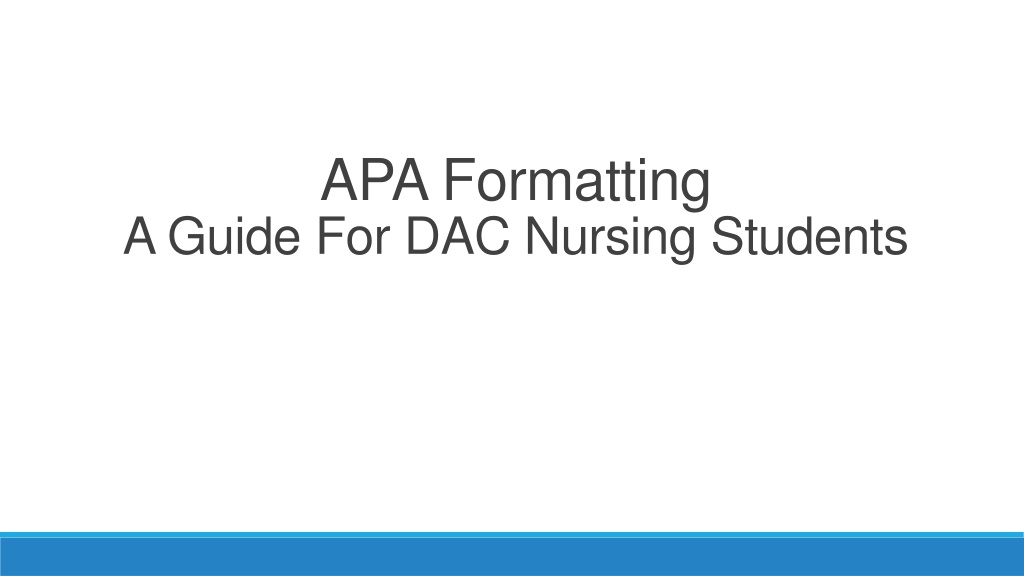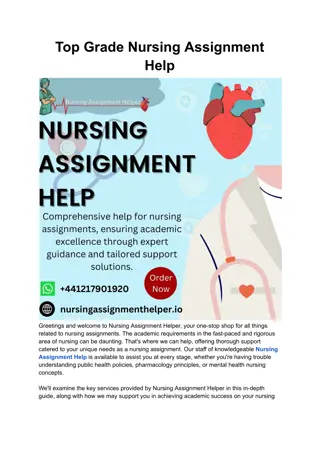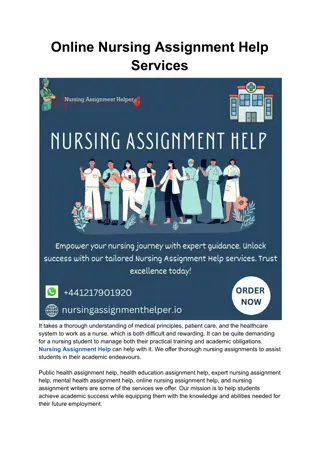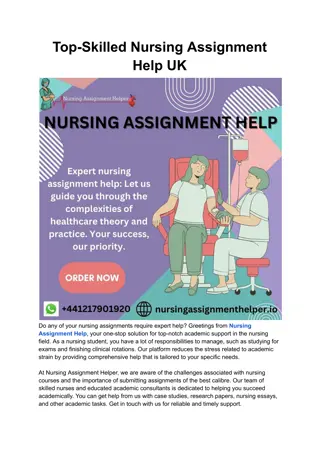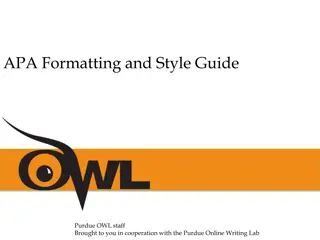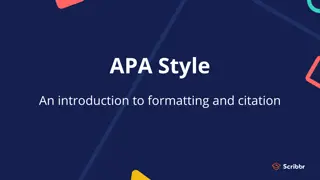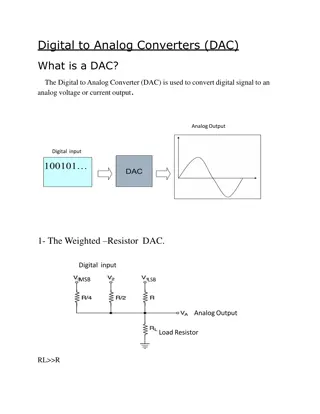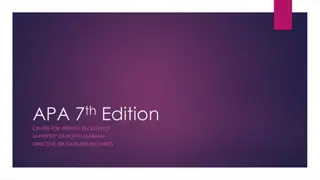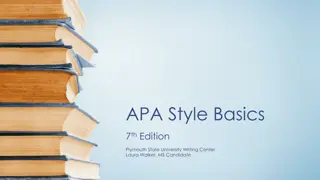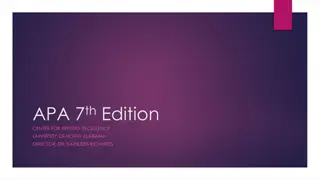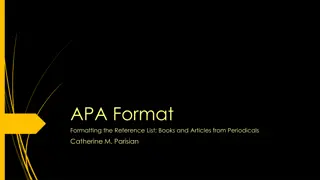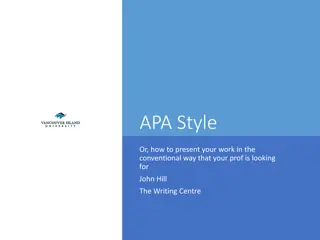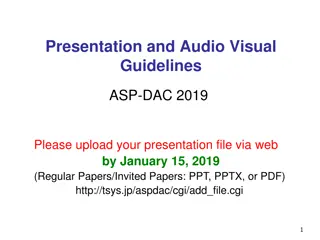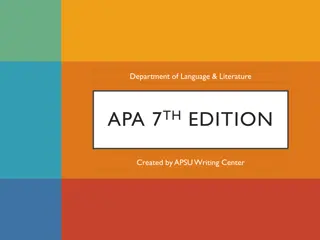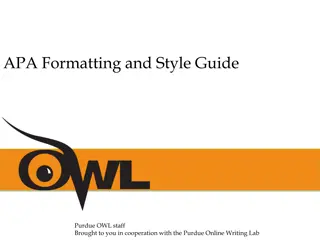APA Formatting: A Comprehensive Guide for DAC Nursing Students
This guide provides detailed instructions on APA formatting rules for nursing students at DAC. It covers general formatting rules, title page components, body of paper structure, and referencing rules. From setting page margins to organizing content with headings, this guide ensures proper compliance with APA style for academic papers.
Download Presentation

Please find below an Image/Link to download the presentation.
The content on the website is provided AS IS for your information and personal use only. It may not be sold, licensed, or shared on other websites without obtaining consent from the author. Download presentation by click this link. If you encounter any issues during the download, it is possible that the publisher has removed the file from their server.
E N D
Presentation Transcript
APA Formatting A Guide For DAC Nursing Students
General Formatting Rules General Formatting Rules *Page setup: 1 inch margins *Font: Times New Roman 12, Calibri 11, Arial 11, Lucinda Sans Unicode 10, and Georgia 11 *Paragraph settings: *Double Spaced *No extra space between paragraphs *Page numbers: *Top right corner
Title Page Components Title Page Components 1. Title 2. Subtitle if necessary 3. Course 4. Course number 5. Disclosure statement 6. Date 7. Page number
Title Page Components (cont.) *Title: *Centered, Middle line, half way down the page *Full course name: *Centered, below the title *Course Number: *Centered, below the course name
Title Page Components (cont.) *Student name: *Centered, middle line, below the course number *Mandatory disclosure statement: A course assignment presented to Nursing Department in partial fulfillment of the requirements for the Associate of Science Degree at De Anza College *Date: *Centered long form (i.e. Month, DD, YYYY) *Last line on the title page
Body of Paper * Abstract: *Brief description of the content *May not be required for short academic papers (clarify with instructor) *Title: *Centered, normal typeface *Top of the page *Introduction: *Introduce the purpose of the paper *Briefly outline the main topics of discussion
Body of Paper (cont.) *Use headings to organize content: * APA recognizes 6 levels of headings, you will rarely use more than 3: 1. Level 1: bold, capitalized, centered 2. Level 2: bold, capitalized, flush left 3. Level 3: indented, lower case, paragraph heading with period at the end. *References: *Content must be correct *Conclusion: *Level 1 heading separating it from the rest of the paper *Briefly summarize the paper, comment on your learning or future scholarly interests
Referencing Rules * A single author: * diam sed orci (Author, YYYY) * Author (YYYY) diam sed orci . * Two authors: * diam sed orci (Author & Author, YYYY). * . diam Author and Author (YYYY) sed orci * Use & only inside parenthesis
Referencing Rules * 3 to 6 authors: *Et al. should be used in in-text citations with more than two authors *This change includes initial citation *Example: * To cite a reference by Jones, Cason and Bond (2004), you will say : Jones et al. (2004)
Referencing Rules *An agency as an author: *If acronym previously defined: tincidunt metus (ANA, 1996) * If acronym not previously defined: ticnidunt metus (American Nursing Academy [AMA], 1996) .
Reference List * Reference entries MUST correspond to the reference entries used in the body of the paper * Format: 1. Goes on the first empty page after the last paragraph 2. Hanging indent 3. Double spaced 4. Entries organized in alphabetical order
Reference List: Books * Author, F., Author, F & Author, F. (YYYY). Title of the book. Publisher. 1. List all authors by last name and first initial, separate the names by comma and/or ampersand as appropriate 2. Year of the publication 3. Title of the book italicized, NOT CAPITALIZED except the first word and parts separated by ; , : and period. 4. Publisher s name Bandura, A. (1997). Self-efficacy: The exercise of control. W. H. Freeman and Co.
Reference List: Journal Articles * Author, F., Author, F & Author, F. (YYYY). Title of the article. Journal Name, Volume(Issue), page(s). 1. List author(s) and year (see Reference List: Books for formatting) 2. Article title normal typeface, NOT CAPITALIZED except the first word and parts separated by ; , : and period. 3. Journal Name italicized and capitalized 4. Volume number if available italicized 5. Issue number normal typeface, in brackets 6. Page(s) range starting with the title and ending with last reference Jones, M. E., Cason, C. L. & Bond, M. L. (2004). Cultural attitudes, knowledge and skills of health workforce. Journal of Transcultural Nursing, 15(4), 283-290.
Reference List: Online Sources * Author, F., Author, F & Author, F. (YYYY). Title. (Journal identifiers if available. exact url . 1. List author(s) and year (see Reference List: Books for formatting) 2. Article title normal typeface, NOT CAPITALIZED except the first word and parts separated by ; , : and period. 3. Journal identifiers if available (see previous slide) 4. Followed by URL which is italicized Institute of Medicine (2002). Unequal treatment: What healthcare providers need to know about racial and ethnic disparities in healthcare. http://www.iom.edu/~/media/Files/Report%20Files/2003/ Unequal-Treatment- Confronting-Racial-and-Ethnic-Disparities-in-HealthCare/DisparitiesAdmin8pg.pdf
Reference List: Chapter in Edited Book * Author, F. (YYYY). Title of the chapter. In F. Editor (Ed.). Title of the book (pp. XX-XX). City, State: Publisher. 1. List author(s) and year (see Reference List: Books for formatting) 2. Title of the chapter normal typeface, not capitalized 3. In Editor(s) name (First initial followed by last name) 4. Editor designation (Ed. if 1 editor; Eds for multiple editors). 5. Title of the book italicized, NOT CAPITALIZED except the first word and part separated by ; , : and period. 6. Page numbers for the chapter in brackets (pp. XX-XX). 7. Publisher s name Miskin, P. (1997). Childhood obesity is a global health concern. In J. Langwith (Ed.), Perspectives on diseases in disorders: Childhood obesity. Gale Cengage Learning.
Appendix/ Appendices * Generally used to provide additional and complimentary information such as graphs, tables, figures, etc. * Included after the reference list * Include alphabetic designation in the title (e.g. Appendix A, Appendix B, etc.) * Title of the appendix on top of the page * Formatting vary depending on the information presented
